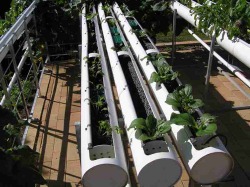Common Hydroponic Systems

To a lot of men and women like hobbyists, farmers as well as world government, Hydroponics, growing crops without soil, is becoming increasingly more common. By way of various types of exposing the plant roots on to a water-nutrient solution, hydroponic systems help it become probable to nurture crops practically anywhere light and temperature could be regulated-which might be specifically beneficial in third-world countries, locations where the soil is unproductive, the arctic regions, and much more.
The way the plant is anchored and the way the roots are fed are the variations of various ways of growing plants this way. Here are many of the more common hydroponic systems.
The way the plant is anchored and the way the roots are fed are the variations of various ways of growing plants this way. Here are many of the more common hydroponic systems.
EBB AND FLOW
Or Flood-and-Drain as a few could call it, in which the water nutrient solution floods the tank routinely, drains back in one more tank and be recycled, the crops with this technique are placed in trays that are hanging over a nutrient chamber. To control the ebb-and-flow cycle, generally, a water pump can be used. This is the most common among the hydroponic systems.
DRIP SYSTEM
Much like the Ebb-and-Flow however as an alternative to flooding the entire reservoir, a constant drip of solution is pumped in the growth tray, generally, additionally , it gets the similar set-up with Ebb-and-Flow.
WATER CULTURE SYSTEM
On this fuss-free set up, the plant containers effectively drift in the nutrient reservoir, the plant roots dangling in the solution. So that you can oxygenate the solution, an air pump is employed sometimes. This set up will work for newbies, yet a little more challenging to control. In hydroponics, this is just about the oldest approach.
Or Flood-and-Drain as a few could call it, in which the water nutrient solution floods the tank routinely, drains back in one more tank and be recycled, the crops with this technique are placed in trays that are hanging over a nutrient chamber. To control the ebb-and-flow cycle, generally, a water pump can be used. This is the most common among the hydroponic systems.
DRIP SYSTEM
Much like the Ebb-and-Flow however as an alternative to flooding the entire reservoir, a constant drip of solution is pumped in the growth tray, generally, additionally , it gets the similar set-up with Ebb-and-Flow.
WATER CULTURE SYSTEM
On this fuss-free set up, the plant containers effectively drift in the nutrient reservoir, the plant roots dangling in the solution. So that you can oxygenate the solution, an air pump is employed sometimes. This set up will work for newbies, yet a little more challenging to control. In hydroponics, this is just about the oldest approach.
WICK SYSTEM
Yet another simple set up, using this method demands no pump. Wicks, just like the ones utilized in oil lamps soak up the nutrients solution and given to the plant roots inside the growth tray. While this method demands tiny upkeep, the roots can over-soak because the solution does not cycle out of the tray.
NUTRIENT FILM TECHNIQUE
"Film," identifies a slow moving flow of nutritious solution that's pumped from one side and empties out the other with plant roots dangling in it, a far more complex method. This method requires lots of attention and regulation, but can create large yields since the roots are hugely nurtured.
AEROPONICS
One more very effective approach to growing that's very sophisticated. With this technique, the roots are dangling in the air and sprayed with a fine mist of nutrient solution for the reason that plants have no medium to anchor them. Necessitating much more regulation, nourishing the roots are maximized.
These would be the most common kinds of many hydroponic systems. Which you go for depends on your understanding level, precisely what crops you are growing and what kind of outcomes you are looking for.
Yet another simple set up, using this method demands no pump. Wicks, just like the ones utilized in oil lamps soak up the nutrients solution and given to the plant roots inside the growth tray. While this method demands tiny upkeep, the roots can over-soak because the solution does not cycle out of the tray.
NUTRIENT FILM TECHNIQUE
"Film," identifies a slow moving flow of nutritious solution that's pumped from one side and empties out the other with plant roots dangling in it, a far more complex method. This method requires lots of attention and regulation, but can create large yields since the roots are hugely nurtured.
AEROPONICS
One more very effective approach to growing that's very sophisticated. With this technique, the roots are dangling in the air and sprayed with a fine mist of nutrient solution for the reason that plants have no medium to anchor them. Necessitating much more regulation, nourishing the roots are maximized.
These would be the most common kinds of many hydroponic systems. Which you go for depends on your understanding level, precisely what crops you are growing and what kind of outcomes you are looking for.
